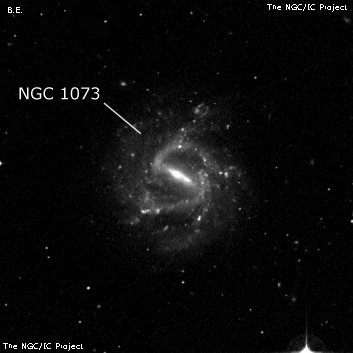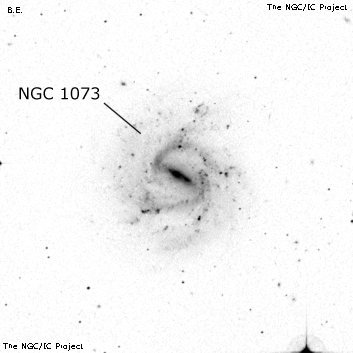NGC/IC Project Restoration Effort
(This is a very very beta version)
NGC1073


Basic Information
Location and Magnitude
Right Ascension: 2:43:40.3
Declination: +1:22:34
Constellation: CET
Visual Magnitude: 11.0
Historic Information
Discoverer: Herschel W.
Year of discovery: 1785
Discovery aperture: 18.7
Observational
Summary description: vF, L, lbM, er
Sub-type: SBc
Steve's Notes
=====
NGC 1073
48" (10/24/14): at 488x; the central bar is very bright and well-defined, extending 1.0'x0.3' SW-NE. An easily visible spiral arm is attached at the northeast end of the bar and extends at a right angle to the northwest, passing through a mag 16 star [50" N of center]. The arm then dims but sweeps clockwise around the west side, and merges with the second arm attached at the southwest end of the bar. As a result, the galaxy appears to have a single continuous arm rotating ~270¡ and ending on the southeast side, ~1.2' from center! The outer part of the halo has a low surface brightness but extends at least 4' in diameter. Another mag 16 star is on the southwest side of the halo [1.4' from center].
At least three HII complexes were identified. The brightest is NGC 1073:[HK 83] 6/9, an elongated patch ~13"x8" E-W, situated at or just beyond the southeast end of the spiral arm [1.4' from center]. A small, fainter knot close west, [HK83] 19, was difficult to resolve. [HK83] 69, a faint 10" knot, is on the west side of the halo (beyond the arm) [1.4' due west of center]. Finally, [HK83] 49 is a third 10" knot of low contrast in the northwest outer halo [1.9' NNW of center]. The designations are from Hodge and Kennicutt's 1983 "An Atlas of HII Regions in 125 Galaxies".
13.1" (9/3/83): fairly faint, large, even surface brightness, round. An equilateral triangle consisting of three mag 9.5-10.5 stars with sides 5' lies SW.
8" (11/28/81): very faint, fairly large, very diffuse, round. Three mag 10 stars are close SW.



